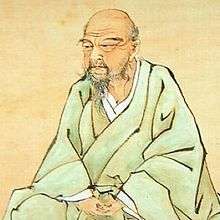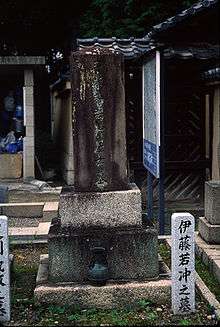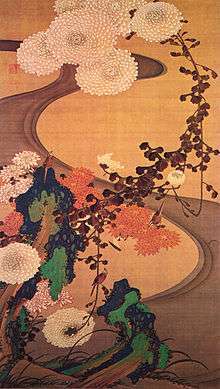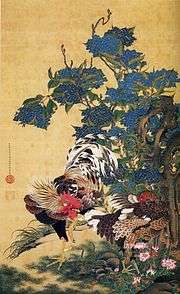Itō Jakuchū

Itō Jakuchū (伊藤 若冲, 2 March 1716 – 27 October 1800)[1] was a Japanese painter of the mid-Edo period when Japan had closed its doors to the outside world. Many of his paintings concern traditionally Japanese subjects, particularly chickens and other birds. Many of his otherwise traditional works display a great degree of experimentation with perspective, and with other very modern stylistic elements.
Compared to Soga Shōhaku and other exemplars of the mid-Edo period eccentric painters, Jakuchū is said to have been very calm, restrained, and professional. He held strong ties to Zen Buddhist ideals, and was considered a lay brother (koji); but he was also keenly aware of his role within a Kyoto society that was becoming increasingly commercial.
Life

Itō Jakuchū was the eldest son of Itō Genzaemon, a Kyoto grocer whose shop, called Masuya, lay in the center of downtown, in the Nishiki food district. Jakuchū ran the shop from the time of his father's death in 1739 until 1755, when he turned it over to one of his brothers.
His training in paintings was mostly derived from inspirations from nature and from examining Chinese paintings at Zen temples. Some sources indicate that he may have studied with Ōoka Shunboku, an Osaka-based artist known for his bird and flower paintings. Though a number of his paintings depict exotic or fantastic creatures, such as tigers and phoenixes, it is evident from the detail and lifelike appearance of his paintings of chickens and other animals that he based his work on actual observation.

Jakuchū built a two-story studio on the west bank of the Kamo River in his late thirties. He called it Shin'en-kan (心遠館, Villa of the Detached Heart [or Mind]), after a phrase from a poem by the ancient Chinese poet Tao Qian. It was around this time that Jakuchū befriended Daiten Kenjō, a Rinzai monk who would later become abbot of the Kyoto temple Shōkoku-ji. Through this friendship Jakuchū gained access to the temple's large collection of Chinese and Japanese paintings, and gained introduction to new social and artistic circles. It is thought that Daiten may have been the one to first conceive of the name "Jakuchū", taken from the Tao Te Ching and meaning "like the void".
Well-known and well-reputed in the Kyoto art community, Jakuchū received many commissions for screen paintings, and was at one time featured above a number of other notable artists in the Record of Heian Notables (平安人物誌, Heian jinbutsu-shi). In addition to personal commissions, Jakuchū was also commissioned to paint panels or screens for many Buddhist temples and Shinto shrines across Japan, including the very famous and important Rokuon-ji (the monastery which includes the Kinkaku-ji Golden Pavilion on its grounds).
Despite his commercial successes, however, Jakuchū can definitely be said to have lived the life of a literary intellectual (bunjin). He was friends with many notable bunjin, went on journeys with them, and was influenced by their artistic styles. His own degree of experimentation was a result of a combination of this bunjin influence and his own personal creative drive. In addition to his experiments with Western materials and perspective, Jakuchū also employed on occasion a method called taku hanga (拓版画, "rubbing prints"). This method used woodblocks to resemble a Chinese technique of ink rubbings of inscribed stone slabs, and was employed by Jakuchū in a number of works, including a scroll entitled "Impromptu Pleasures Afloat" (乗興舟, Jōkyōshū), depicting a journey down the Yodo River.
Despite his individualism and involvement in the scholarly and artistic community of Kyoto, Jakuchū was always strongly religious, and retired towards the end of his life to Sekihō-ji, a Manpuku-ji branch temple on the southern outskirts of Kyoto. There, he gathered a number of followers, and continued to paint until his death at the age of eighty-five.
Works


Most of Jakuchū's works were in the form of hanging scrolls, painted in a combination of Chinese and traditional Japanese methods and styles. A very common theme among his work is birds, in particular chickens and roosters, though several of his more famous paintings depict cockatoos, parrots, and phoenixes.
One of his most ambitious endeavors, and therefore most famous works, is known as the "Pictures of the Colorful Realm of Living Beings" (動植綵絵, Dōshoku sai-e). Begun around 1757 and not finished until 1765, the Pictures are a set of twenty-seven hanging scrolls created as a personal offering to the Shōkoku-ji temple. They depict a number of animal subjects in monumental scale and with an according degree of detail.
Another of his famous pieces, dubbed "Birds and Animals in the Flower Garden" (鳥獣花木図屏風, Chōjūkaboku-zu byōbu), is arguably one of the most modern-looking pieces to come out of Japan during this period. The piece, one of a pair of sixfold screens, depicts a white elephant and a number of other animals in a garden. What makes it unique, eccentric and modern is the division of the entire piece into a grid of squares roughly a centimeter on each side. Each square was colored individually, in order to create the resulting aggregate image. It is part of the Price Collection of the Shin'enkan Foundation in Los Angeles.
Jakuchū also experimented with a number of forms of printing, most of them using woodblocks. But occasionally he would use stencils or other methods to produce different effects. Jakuchū’s painting style is deeply influenced by Shen Nanping (Shen Quan c. 1682–1760). His subjects prove this, being part of traditional Japanese legacy, but also the neutral background and the ‘cut’ given to the scene composition, with always a careful and detailed flora and fauna decorative style of painting.[2]
See also
References
- ↑ http://www.britannica.com/EBchecked/topic/298027/Ito-Jakuchu
- ↑ Marco, Meccarelli. 2015. "Chinese Painters in Nagasaki: Style and Artistic Contaminatio during the Tokugawa Period (1603-1868)" Ming Qing Studies 2015, Pages 175-236.
- Rosenfield, John M. (1999). Extraordinary Persons: Works by Eccentric, Nonconformist Japanese Artists of the Early Modern Era (1580–1868) in the Collection of Kimiko and John Powers. Cambridge, Massachusetts: Harvard Art Museums.
External links
| Wikimedia Commons has media related to Ito Jakuchu. |
- 'Shohaku Show' at the Kyoto National Museum
- Ito Jakuchu's Colorful Realm of Living Beings at the National Gallery of Art, Washington
- An Interview with Joe & Etsuko Price, Collectors of Japanese Art including the world's largest private collection of Jakuchū paintings
- Bridge of dreams: the Mary Griggs Burke collection of Japanese art, a catalog from The Metropolitan Museum of Art Libraries (fully available online as PDF), which contains material on Itō Jakuchū (see index)
Further reading
- Lippit, Yukio (2012). Colorful Realm: Japanese Bird-and-Flower by Itō Jakuchū. University of Chicago Press. ISBN 978-0-226-48460-0.